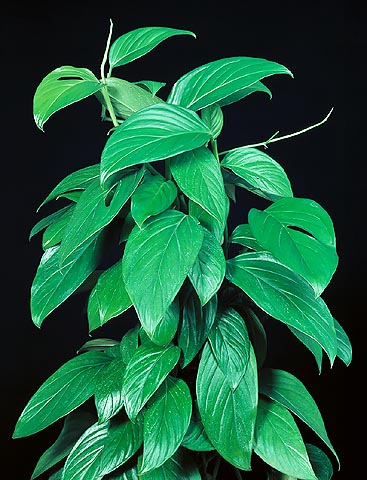Family : Araceae

Text © Pietro Puccio

English translation by Mario Beltramini

Heterophyllous leaves. May be tilled in various ways © G. Mazza
The Monstera acuminata K. Koch (1855) is native to the humid forests of North-Eastern, Central and Southern Mexico, Belize, Guatemala, Honduras and Nicaragua.
The name of the genus is of unsure origin, after some, it should come from the Latin “monstrum” = wonder, exceptional thing; the Latin name of the species “acuminata” = sharp, pointed, refers to the apex of the leaf.
Common names: “shingle plant” (English); “arpón”, “bejuco de arpón”, “bejuco de tuza”, “bejuco negro”, “conté arpón”, “conté de mimbre”, “mimbre”, “mimbre de tuza” (Spanish); “Spitzes Fensterblatt” (German).
Evergreen hemiepiphytic climber, with stems long up to 20 m and more, with 5-10 cm internodes and with a diameter of about 4 cm with several aerial roots, in particular by the nodes, with which it clings to the trunks of the trees.
The leaves present the phenomenon of the heterophilly (bearing foliage leaves of different forms on the same plant), are ovate-cordate, asymmetric in the young plants, with a whole margin and irregular openings, 8-20 cm long; in the adult plants, the leaves are ovate, 35-75 cm long and 15-40 cm broad, with whole lamina with not many openings, slightly falcate and hanging, of an intense green colour above, paler under, and a sharp apex; the petioles are 12-40 cm long and wrinkled on the upper side.
The inflorescence, which appears in the adult plants with stems long more than ten metres, is axillar, single, formed by a 10-20 cm long spadix, greenish white, surrounded by an oblong spathe of 12-22 cm of length, externally greenish-white, cream-white internally; the spadix turns to yellow when ripe; the fruits are berries with white or grey pulp, usually containing one oblong, about 18×6 mm, seed, of green colour.
It usually reproduces by division, layering, point cutting and by portions of stem, which easily root also in water. The plant can be cultivated in open spaces in tropical and humid subtropical regions, where it can be utilized, both in shade and in filtered sunlight, to cover soil, rocks or walls, or left climbing on trees where it adheres with its aerial roots. Elsewhere, it is to be cultivated in pot in luminous position and can be utilized as hanging or climbing on bog moss covered supports or by syntethic material suitable for keeping the humidity. It needs very porous, draining and rich of organic substance substrata, and temperatures above 14-16°C, best around 20-22°C. Watering must be frequent in summer, reduced in winter, always avoiding water stagnations which can cause rottenness.
All the parts of the plant contain toxic substances, in particular calcium oxalate, which can be irritating.
Synonyms: Monstera karwinskyi Schott (1859); Monstera dimidiata Schott (1860); Monstera belizensis Lundell (1939); Monstera grandifolia Standl. & Steyerm. (1947); Monstera chiapensis Matuda (1949); Monstera viridispatha Matuda (1950).
